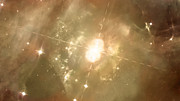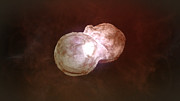Detailed look on Eta Carinae
Highest resolution image of Eta Carinae
Digitized Sky Survey Image of Eta Carinae Nebula
The Carina Nebula in the constellation of Carina
Panoramic view of the WR 22 and Eta Carinae regions of the Carina Nebula*
One Picture, Many Stories
The Carina Nebula imaged by the VLT Survey Telescope
Eta Carinae
Videos
VLT Interferometer captures raging winds in famous massive stellar system
An international team of astronomers have
used the Very Large Telescope Interferometer to image the Eta Carinae
star system in the greatest detail ever achieved. They found new and
unexpected structures within the binary system, including in the area
between the two stars where extremely high velocity stellar winds are
colliding. These new insights into this enigmatic star system could lead
to a better understanding of the evolution of very massive stars.
Led by Gerd Weigelt from the Max Planck Institute for Radio Astronomy (MPIfR) in Bonn, a team of astronomers have used the Very Large Telescope Interferometer (VLTI) at ESO’s Paranal Observatory to take a unique image of the Eta Carinae star system in the Carina Nebula.
This colossal binary system consists of two massive stars orbiting each other and is very active, producing stellar winds which travel at velocities of up to ten million kilometres per hour [1]. The zone between the two stars where the winds from each collide is very turbulent, but until now it could not be studied.
The power of the Eta Carinae binary pair creates dramatic phenomena. A “Great Eruption”
in the system was observed by astronomers in the 1830s. We now know
that this was caused by the larger star of the pair expelling huge
amounts of gas and dust in a short amount of time, which led to the
distinctive lobes, known as the Homunculus Nebula,
that we see in the system today. The combined effect of the two stellar
winds as they smash into each other at extreme speeds is to create
temperatures of millions of degrees and intense deluges of X-ray
radiation.
The central area where the winds collide is so
comparatively tiny — a thousand times smaller than the Homunculus Nebula
— that telescopes in space and on the ground so far have not been able
to image them in detail. The team has now utilised the powerful
resolving ability of the VLTI instrument AMBER to peer into this violent realm for the first time. A clever combination — an interferometer — of three of the four Auxiliary Telescopes at the VLT lead to a tenfold increase in resolving power in comparison to a single VLT Unit Telescope. This delivered the sharpest ever image of the system and yielded unexpected results about its internal structures.
The new VLTI image clearly depict the structure which
exists between the two Eta Carinae-stars. An unexpected fan-shaped
structure was observed where the raging wind from the smaller, hotter
star crashes into the denser wind from the larger of the pair.
“Our dreams came true, because we can now get extremely
sharp images in the infrared. The VLTI provides us with a unique
opportunity to improve our physical understanding of Eta Carinae and
many other key objects”, says Gerd Weigelt.
In addition to the imaging, the spectral observations of
the collision zone made it possible to measure the velocities of the
intense stellar winds [2].
Using these velocities, the team of astronomers were able to produce
more accurate computer models of the internal structure of this
fascinating stellar system, which will help increase our understanding
of how these kind of extremely high mass stars lose mass as they evolve.
Team member Dieter Schertl (MPIfR) looks forward: “The new VLTI instruments GRAVITY
and MATISSE will allow us to get interferometric images with even
higher precision and over a wider wavelength range. This wide wavelength
range is needed to derive the physical properties of many astronomical
objects.”
Notes
[1] The two stars are so massive and bright that the
radiation they produce rips off their surfaces and spews them into
space. This expulsion of stellar material is referred to as stellar
“wind”, and it can travel at millions of kilometres per hour.
More Information
This research was presented in a paper to appear in Astronomy and Astrophysics.
The team is composed of G. Weigelt (Max Planck Institute
for Radio Astronomy, Germany), K.-H. Hofmann (Max Planck Institute for
Radio Astronomy, Germany), D. Schertl (Max Planck Institute for Radio
Astronomy, Germany), N. Clementel (South African Astronomical
Observatory, South Africa) , M.F. Corcoran (Goddard Space Flight Center,
USA; Universities Space Research Association, USA), A. Damineli
(Universidade de São Paulo, Brazil ), W.-J. de Wit (European Southern
Observatory, Chile), R. Grellmann (Universität zu Köln, Germany), J.
Groh (The University of Dublin, Ireland ), S. Guieu (European Southern
Observatory, Chile), T. Gull (Goddard Space Flight Center, USA), M.
Heininger (Max Planck Institute for Radio Astronomy, Germany) , D.J.
Hillier (University of Pittsburgh, USA), C.A. Hummel (European Southern
Observatory, Germany), S. Kraus (University of Exeter, UK), T. Madura
(Goddard Space Flight Center, USA), A. Mehner (European Southern
Observatory, Chile), A. Mérand ( European Southern Observatory, Chile),
F. Millour (Université de Nice Sophia Antipolis, France), A.F.J. Moffat
(Université de Montréal, Canada), K. Ohnaka (Universidad Católica del
Norte, Chile), F. Patru (Osservatorio Astrofisico di Arcetri, Italy),
R.G. Petrov (Université de Nice Sophia Antipolis, France), S. Rengaswamy
(Indian Institute of Astrophysics, India) , N.D. Richardson (The
University of Toledo, USA), T. Rivinius (European Southern Observatory,
Chile), M. Schöller (European Southern Observatory, Germany), M. Teodoro
(Goddard Space Flight Center, USA) , and M. Wittkowski (European
Southern Observatory, Germany)
ESO is the foremost intergovernmental astronomy
organisation in Europe and the world’s most productive ground-based
astronomical observatory by far. It is supported by 16 countries:
Austria, Belgium, Brazil, the Czech Republic, Denmark, France, Finland,
Germany, Italy, the Netherlands, Poland, Portugal, Spain, Sweden,
Switzerland and the United Kingdom, along with the host state of Chile.
ESO carries out an ambitious programme focused on the design,
construction and operation of powerful ground-based observing facilities
enabling astronomers to make important scientific discoveries. ESO also
plays a leading role in promoting and organising cooperation in
astronomical research. ESO operates three unique world-class observing
sites in Chile: La Silla, Paranal and Chajnantor. At Paranal, ESO
operates the Very Large Telescope, the world’s most advanced
visible-light astronomical observatory and two survey telescopes. VISTA
works in the infrared and is the world’s largest survey telescope and
the VLT Survey Telescope is the largest telescope designed to
exclusively survey the skies in visible light. ESO is a major partner in
ALMA, the largest astronomical project in existence. And on Cerro
Armazones, close to Paranal, ESO is building the 39-metre European
Extremely Large Telescope, the E-ELT, which will become “the world’s
biggest eye on the sky”.
Links
Contacts
Max-Planck-Institut für Radioastronomie
Bonn, Germany
Tel: +49 228 525 243
Email: weigelt@mpifr-bonn.mpg.de
Dieter Schertl
Max-Planck-Institut für Radioastronomie
Bonn, Germany
Tel: +49 228 525 301
Email: ds@mpifr-bonn.mpg.de
Norbert Junkes
Public Information Officer, Max-Planck-Institut für Radioastronomie
Bonn, Germany
Tel: +49 228 525 399
Email: njunkes@mpifr-bonn.mpg.de
Mathias Jäger
Public Information Officer
Garching bei München, Germany
Tel: +49 176 62397500
Email: mjaeger@partner.eso.org
Source: ESO









